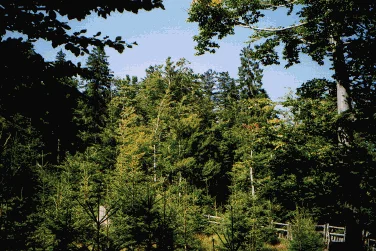SUSTAINABLE MANAGEMENT OF MOUNTAIN FORESTS IN THE CZECH REPUBLIC

Mountain forests are an important landscape component of this country. They are an object of specific importance from the aspect of natural environment conservation, stabilization of natural processes and general landscape homeostasis. In addition, they fulfil a number of production and non-production functions.
Cardinal elements of sustainable forest management in the CR conditions are as follows:
management of the forest as an ecosystem, i.e. transition from exclusive care of forest tree species and their stands to care of the whole forest ecosystems, restructuring (conversion, reconstruction) of damaged and declining forests, optimum (species, genetic, spatial, age) structure of forest ecosystems differentiated according to site conditions and management targets, differentiated transition from general management to group or individual methods, utilization and support of spontaneous processes such as natural regeneration, competition and other principles of self-regulation.
The above cardinal elements of sustainable forest management are applicable to forests of the CR in general, but their importance considerably increases in mountain forests where many species survive on the margin of subsistence. Moreover, mountain forests of CR have been heavily destroyed by anthropogenic factors, especially air-pollution ecological stresses, during the last three or four decennia
Principles of sustainable mountain forest management
Cardinal elements of sustainable forest management in the Czech Republic’s conditions are as follows:
management of the forest as an ecosystem, i.e. transition from exclusive care of forest tree species and their stands to care of the whole forest ecosystems, restructuring (conversion, reconstruction) of damaged and declining forests, optimum (species, genetic, spatial, age) structure of forest ecosystems differentiated according to site conditions and management targets, differentiated transition from general management to group or individual methods, utilization and support of spontaneous processes such as natural regeneration, competition and other principles of self-regulation, support and creation of flexible multiple-purpose management methods, differentiated according to the functions and capacities of forest ecosystems in order to achieve their functional equilibrium.
The above cardinal elements of sustainable forest management are applicable to forests of the CR in general, but their importance considerably increases in mountain forests where many species survive on the margin of subsistence. Moreover, mountain forests of CR have been heavily destroyed by anthropogenic factors, especially air-pollution ecological stresses, in the last three or four decenia.
Management complexes (MC) are fundamental super-structural units of forest typology for forest operations and forest planning in the CR. The framework of permanent natural conditions in these complexes is constituted by cognate management of associated “forest site type groups” that have common target methods and forms of management and target tree species composition. There are 24 target MC in the category of commercial forests that are also applicable to special-purpose forests, and 3 MC in the category of protection forests.
Management of forests at the highest locations, i.e. in Dwarf Pine, Spruce and Spruce with Beech forest vegetation zones, and in the remaining mountain locations of lower altitudes is completely different. In the first case, it is management at elevated mountain locations (MC 71 – exposed, 73 – acid, 75 – fertile, 77 – gleyic and 79 – water-logged sites of mountain locations) and in respective protection forests (MC 01, 02 and 03, i.e. extremely unfavorable sites, high-elevation forests below the forest limit, forests in the dwarf pine vegetation zone). A spruce forest or a forest with dominant Norway spruce grows in almost marginal conditions of subsistence and is strongly exposed to air pollution. The disintegration of older, particularly allochthonous stands is inevitable at these locations; therefore their regeneration should start as soon as possible. On the other hand, complex silvi cultural measures can prolong the lifetime of young and medium-age stands and of many older autochthonous stands.
 Albania
Albania Algeria
Algeria Andorra
Andorra Argentina
Argentina Armenia
Armenia Australia
Australia Austria
Austria Azerbaijan
Azerbaijan Bahrain
Bahrain Belgium
Belgium Bolivia
Bolivia Brazil
Brazil Bulgaria
Bulgaria Cambodia
Cambodia Cameroon
Cameroon Canada
Canada Chad
Chad Chile
Chile China
China Colombia
Colombia Costa Rica
Costa Rica Croatia
Croatia Cyprus
Cyprus Czechia
Czechia Denmark
Denmark Ecuador
Ecuador Egypt
Egypt Finland
Finland France
France Georgia
Georgia Germany
Germany Ghana
Ghana Greece
Greece Hungary
Hungary Iceland
Iceland India
India Indonesia
Indonesia Ireland
Ireland Italy
Italy Jamaica
Jamaica Japan
Japan Jordan
Jordan Kazakhstan
Kazakhstan Kenya
Kenya Kuwait
Kuwait Latvia
Latvia Lebanon
Lebanon Libya
Libya Lithuania
Lithuania Luxembourg
Luxembourg Malaysia
Malaysia Maldives
Maldives Mali
Mali Malta
Malta Mexico
Mexico Moldova
Moldova Monaco
Monaco Morocco
Morocco Netherlands
Netherlands New Zealand
New Zealand Nigeria
Nigeria North Macedonia
North Macedonia Norway
Norway Oman
Oman

